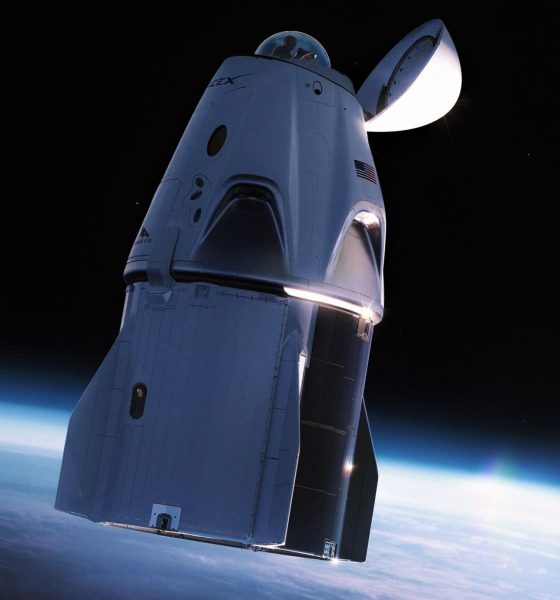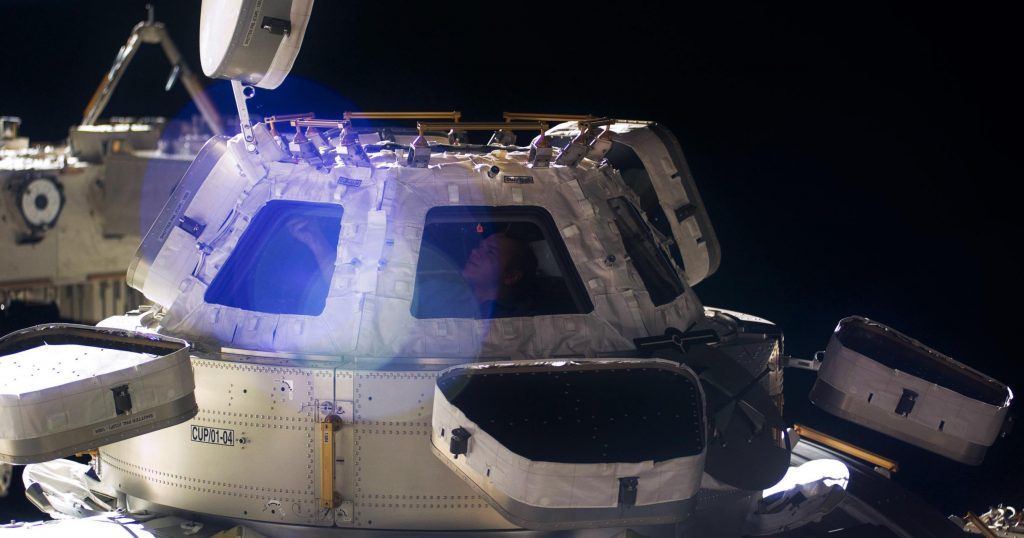

News
SpaceX to upgrade Dragon with the most immersive window ever launched into space
SpaceX and Inspiration4 customer Jared Isaacman have revealed a substantial and unexpected design change made to the Crew Dragon spacecraft that will carry the billionaire and three guests into orbit later this year.
Reminiscent of the beloved “Cupola” (Italian for dome) built by the European Space Agency (ESA) and installed on the International Space Station (ISS) in 2010, SpaceX says it has designed a spectacular ‘glass dome’ window add-on for Crew Dragon. Thanks to some level of newfound commercial interest in free-flying Crew Dragon missions, in which the spacecraft would operate as its own miniature space station for several days, SpaceX concluded that it could fully remove the spacecraft’s docking adapter.
In its place, SpaceX has apparently designed a huge, monolithic, dome-like window that promises to offer a viewing experience likely unmatched in the history of spaceflight.

While the ISS Cupola is reminiscent of Crew Dragon’s glass dome, the two windows are only similar in the sense that they’re both space-based viewing windows. Beyond that, the Dragon Dome is more akin to the ultimate realization of the platonic ideal that ESA engineers tried to achieve with the Cupola. Featuring an approximate 2:1 ratio of framework and structural support material to glass, the Cupola’s central circular window has an uninterrupted diameter of 80 cm (2.6 ft), while the whole assembly has a total internal diameter of ~2m (6.6 ft) and a depth (the ‘height’ of the conical windowed area) of about 50 cm (1.6 ft).
Assuming SpaceX is explicitly designing the dome to integrate with Crew Dragon’s existing International Docking Adapter (IDA) support structure, it could have a diameter as large as 1.4m (~4.5 ft) and a depth of 60 cm (~2 ft; assuming a perfect hemisphere for maximum strength). If SpaceX’s official render is correct, the dome will also be monolithic, meaning that the glass window itself would be completely uninterrupted by structural supports.


Much like the Cupola, which has foldable ‘petals’ that serve as shades and micrometeorite shields when the module isn’t in use, Crew Dragon’s glass dome would be safely enclosed inside the spacecraft’s nosecone. It’s unclear what material the dome would be made out of, given that large, monolithic, bulletproof domes are a technology that effectively does not exist. At least one company, Surmet, specializes in manufacturing aluminum oxynitride (“transparent aluminum”) windows, including small domes for things like missile sensor pods.
However, the maximum size of those commercial ALON domes is roughly half a foot in diameter and there is no evidence that anyone has attempted the produce an ALON dome even a full magnitude smaller than what SpaceX’s Dragon window would require. This is to say that if SpaceX has found a way to produce massive monolithic windows and domes rated for space travel, it will effectively leap from a total outsider to a de facto leader of the niche bulletproof glass dome industry. It’s worth noting that CEO Elon Musk has stated that Tesla’s Cybertruck will feature “transparent metal” windows, which would likely make the EV company the world leader in ALON window mass-production – expertise that SpaceX could borrow from given their history of joint materials R&D.
In a live March 30th event celebrating the final crew selection, SpaceX director Benji Reed stated that NASA has been closely involved with with development of Dragon’s dome window. Most notably, he strongly implied that flight-proven Crew Dragons would be able to swap between dome and docking hardware with enough ease that a Dragon flown with a dome on a SpaceX tourist mission could still be modified to support NASA astronaut launches, thus ensuring commonality within the Dragon ‘fleet’ SpaceX is building.
SpaceX has implied that its Dragon Dome will debut as early as September 2021 on billionaire Jared Isaacman’s Inspiration4 mission – currently on track to become the world’s first fully private astronaut launch.

Elon Musk
Elon Musk confirms xAI’s purchase of five 380 MW natural gas turbines
The deal, which was confirmed by Musk on X, highlights xAI’s effort to aggressively scale its operations.

xAI, Elon Musk’s artificial intelligence startup, has purchased five additional 380 MW natural gas turbines from South Korea’s Doosan Enerbility to power its growing supercomputer clusters.
The deal, which was confirmed by Musk on X, highlights xAI’s effort to aggressively scale its operations.
xAI’s turbine deal details
News of xAI’s new turbines was shared on social media platform X, with user @SemiAnalysis_ stating that the turbines were produced by South Korea’s Doosan Enerbility. As noted in an Asian Business Daily report, Doosan Enerbility announced last October that it signed a contract to supply two 380 MW gas turbines for a major U.S. tech company. Doosan later noted in December that it secured an order for three more 380 MW gas turbines.
As per the X user, the gas turbines would power an additional 600,000+ GB200 NVL72 equivalent size cluster. This should make xAI’s facilities among the largest in the world. In a reply, Elon Musk confirmed that xAI did purchase the turbines. “True,” Musk wrote in a post on X.
xAI’s ambitions
Recent reports have indicated that xAI closed an upsized $20 billion Series E funding round, exceeding the initial $15 billion target to fuel rapid infrastructure scaling and AI product development. The funding, as per the AI startup, “will accelerate our world-leading infrastructure buildout, enable the rapid development and deployment of transformative AI products.”
The company also teased the rollout of its upcoming frontier AI model. “Looking ahead, Grok 5 is currently in training, and we are focused on launching innovative new consumer and enterprise products that harness the power of Grok, Colossus, and 𝕏 to transform how we live, work, and play,” xAI wrote in a post on its website.
Elon Musk
Elon Musk’s xAI closes upsized $20B Series E funding round
xAI announced the investment round in a post on its official website.

xAI has closed an upsized $20 billion Series E funding round, exceeding the initial $15 billion target to fuel rapid infrastructure scaling and AI product development.
xAI announced the investment round in a post on its official website.
A $20 billion Series E round
As noted by the artificial intelligence startup in its post, the Series E funding round attracted a diverse group of investors, including Valor Equity Partners, Stepstone Group, Fidelity Management & Research Company, Qatar Investment Authority, MGX, and Baron Capital Group, among others.
Strategic partners NVIDIA and Cisco Investments also continued support for building the world’s largest GPU clusters.
As xAI stated, “This financing will accelerate our world-leading infrastructure buildout, enable the rapid development and deployment of transformative AI products reaching billions of users, and fuel groundbreaking research advancing xAI’s core mission: Understanding the Universe.”
xAI’s core mission
Th Series E funding builds on xAI’s previous rounds, powering Grok advancements and massive compute expansions like the Memphis supercluster. The upsized demand reflects growing recognition of xAI’s potential in frontier AI.
xAI also highlighted several of its breakthroughs in 2025, from the buildout of Colossus I and II, which ended with over 1 million H100 GPU equivalents, and the rollout of the Grok 4 Series, Grok Voice, and Grok Imagine, among others. The company also confirmed that work is already underway to train the flagship large language model’s next iteration, Grok 5.
“Looking ahead, Grok 5 is currently in training, and we are focused on launching innovative new consumer and enterprise products that harness the power of Grok, Colossus, and 𝕏 to transform how we live, work, and play,” xAI wrote.
Investor's Corner
Tesla gets price target bump, citing growing lead in self-driving

Tesla (NASDAQ: TSLA) stock received a price target update from Pierre Ferragu of Wall Street firm New Street Research, citing the company’s growing lead in self-driving and autonomy.
On Tuesday, Ferragu bumped his price target from $520 to $600, stating that the consensus from the Consumer Electronics Show in Las Vegas was that Tesla’s lead in autonomy has been sustained, is growing, and sits at a multiple-year lead over its competitors.
CES 2026 validates Tesla’s FSD strategy, but there’s a big lag for rivals: analyst
“The signal from Vegas is loud and clear,” the analyst writes. “The industry isn’t catching up to Tesla; it is actively validating Tesla’s strategy…just with a 12-year lag.”
The note shows that the company’s prowess in vehicle autonomy is being solidified by lagging competitors that claim to have the best method. The only problem is that Tesla’s Vision-based approach, which it adopted back in 2022 with the Model 3 and Model Y initially, has been proven to be more effective than competitors’ approach, which utilizes other technology, such as LiDAR and sensors.
Currently, Tesla shares are sitting at around $433, as the company’s stock price closed at $432.96 on Tuesday afternoon.
Ferragu’s consensus on Tesla shares echoes that of other Wall Street analysts who are bullish on the company’s stock and position within the AI, autonomy, and robotics sector.
Dan Ives of Wedbush wrote in a note in mid-December that he anticipates Tesla having a massive 2026, and could reach a $3 trillion valuation this year, especially with the “AI chapter” taking hold of the narrative at the company.
Ives also said that the big step in the right direction for Tesla will be initiating production of the Cybercab, as well as expanding on the Robotaxi program through the next 12 months:
“…as full-scale volume production begins with the autonomous and robotics roadmap…The company has started to test the all-important Cybercab in Austin over the past few weeks, which is an incremental step towards launching in 2026 with important volume production of Cybercabs starting in April/May, which remains the golden goose in unlocking TSLA’s AI valuation.”
Tesla analyst breaks down delivery report: ‘A step in the right direction’
Tesla has transitioned from an automaker to a full-fledged AI company, and its Robotaxi and Cybercab programs, fueled by the Full Self-Driving suite, are leading the charge moving forward. In 2026, there are major goals the company has outlined. The first is removing Safety Drivers from vehicles in Austin, Texas, one of the areas where it operates a ride-hailing service within the U.S.
Ultimately, Tesla will aim to launch a Level 5 autonomy suite to the public in the coming years.








